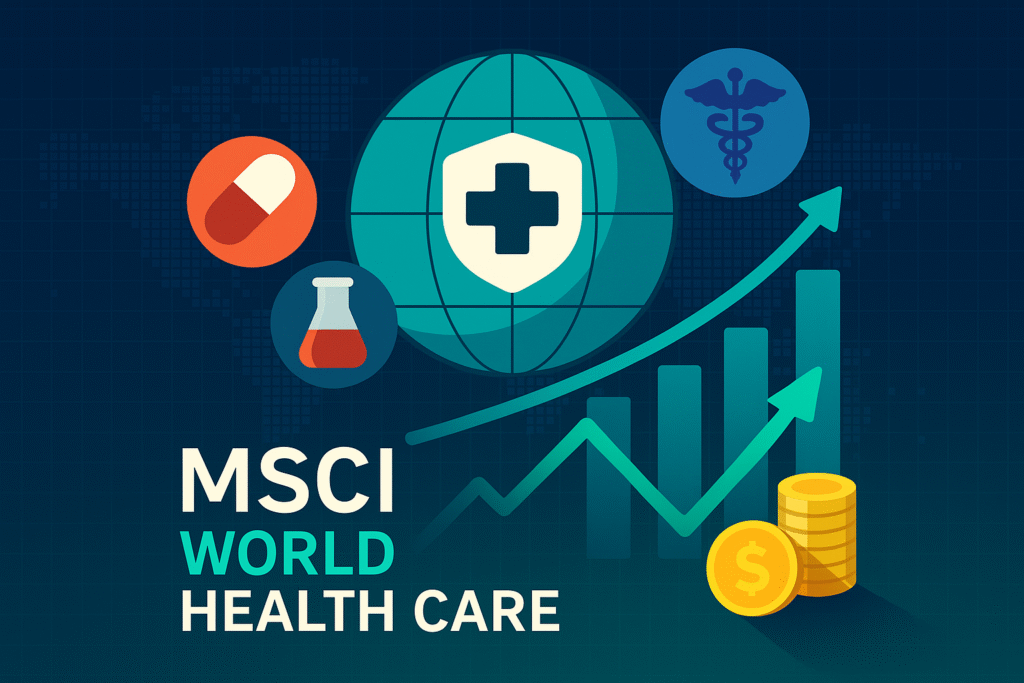A sector-specific benchmark that bundles large- and mid-cap health-care companies from 23 developed markets, thereby offering investors a single, globally diversified snapshot of everything from blockbuster drugmakers to cutting-edge medical-device suppliers.

1. Why the Index Matters
First and foremost, health-care spending rises even when GDP slows; hence, many portfolios rely on this index for defensive equity exposure. Moreover, because the basket mirrors the MSCI World parent, regional and currency weights stay familiar, while the sector purity adds a focused tilt toward innovation and demographic tailwinds.
2. Construction in Brief
| Step | Rule |
|---|---|
| Starting Universe | MSCI World (≈ 1 480 stocks) |
| Sector Screen | GICS “Health Care” code only (pharma, biotech, devices, services) |
| Size Cut-off | Top 85 % of each market’s free-float cap (large + mid caps) |
| Weighting Method | Free-float market cap; single-stock cap ≈ 9 % |
| Rebalance Cadence | Quarterly (Feb, May, Aug, Nov) with full reviews each May & Nov |
Consequently, new IPOs like GLP-1 innovators and surgical-robot makers enter swiftly once they meet liquidity thresholds.
3. Snapshot (April 2025)
| Metric | Value |
|---|---|
| Constituents | ~270 stocks |
| Float-Adj. Market Cap | US $8.4 trillion |
| Index Weight in MSCI World | 14 % |
| Dividend Yield | 1.8 % |
| Regional Split | United States 65 %, Europe 20 %, Japan 7 %, Others 8 % |
| Top Holdings | Eli Lilly 8 %, UnitedHealth 7 %, Novo Nordisk 5 %, Johnson & Johnson 4 % |
Because mega-caps dominate R&D pipelines, the top ten names together move roughly 40 % of daily index points.
4. Recent Performance (USD Total Return)
| Year | Index | MSCI World | Comment |
|---|---|---|---|
| 2022 | –7.1 % | –17.7 % | Defensive earnings cushioned drawdown |
| 2023 | +18.3 % | +20.4 % | GLP-1 obesity drug rally |
| 2024 | +12.6 % | +12.0 % | Med-tech rebound offset FX headwinds |
| YTD 2025 | +5.8 % | +6.1 % | Oncology pipeline beats and M&A rumors |
Volatility (~14 %) runs slightly below the broader market, underscoring the sector’s defensive profile.
5. Investor Use-Cases
- Core Defensive Sleeve: One ETF—think URHE or IXJ—delivers global pharma, biotech and devices in a single trade.
- Benchmarking Active Funds: Sector-focused managers gauge alpha relative to this neutral yard-stick.
- Factor Overlay: Low-beta and high-quality factors dominate, helping risk-parity portfolios.
- Macro Signal: Index underperformance can foreshadow reimbursement pressures or patent cliffs.
6. Strengths & Limitations
| Strengths | Limitations |
|---|---|
| Broad developed-market coverage with 30-year history | No emerging-market innovators until they graduate to DM status |
| Free-float weighting ensures liquidity | Mega-cap dominance may mute breakthrough-small-cap impact |
| Quarterly reviews keep roster current | Currency swings affect USD series; hedged versions required for purity |
7. Themes to Watch
Furthermore, several catalysts could reshape weights at upcoming reviews:
- Obesity-Drug Boom: GLP-1 revenue surge may push Eli Lilly and Novo Nordisk weights closer to the 9 % cap.
- AI Drug Discovery: Fast-entry rules could welcome newly listed AI-first biotechs.
- Med-Tech Automation: Surgical-robot makers gaining market share may lift the equipment sleeve above 15 %.
- Value-Based Care: Managed-care firms innovating payment models could see accelerated earnings growth and higher weights.
Key Takeaways
The MSCI World Health Care Index condenses roughly 270 defensive yet innovative companies into a single, free-float-weighted benchmark. With a 14 % slice of MSCI World, a 1.8 % yield and lower volatility than the parent, it remains the go-to gauge for global health-care beta.